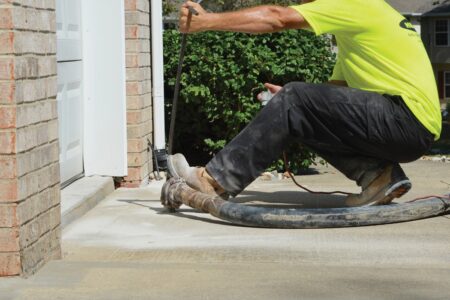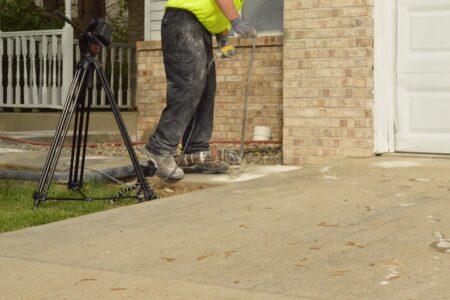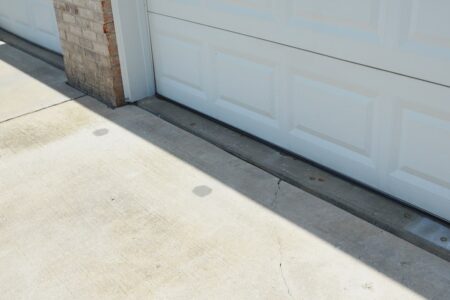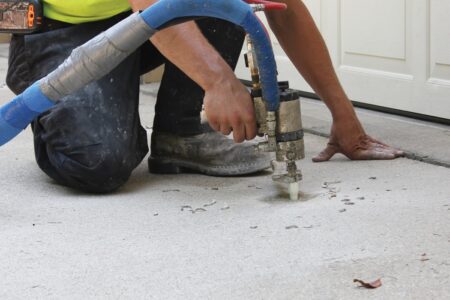Why does concrete sink?
If your sidewalk or driveway is sinking, it’s typically because of the soil underneath. Luckily, Helitech has an easy and cost-effective solution.
It can happen so gradually, you don’t know it’s happening until it’s too late.
Before you know it, your concrete sidewalk or driveway is sinking and cracking. It used to be a smooth surface, and now it’s a tripping hazard when you’re carrying in groceries.
Midwest soils expand when wet and contract when dry, and that can lead to a sinking concrete slab. The concrete is unable to bend or adjust to the ever-changing soil conditions.
A cracked, sinking concrete slab is not only an eyesore but also it can be an indication of a more serious structural issue. A crack in your concrete doesn’t necessarily mean there is a problem but combined with sinking, it’s worth having someone come out and look at it just in case.
What makes a concrete slab sink?
When all or part of a slab sinks, often referred to as slab settlement, the cause is usually one of a few issues:
- The soil beneath the slab may compress easily.
The weight of the concrete slab pushes down on the soil, causing itself to sink. During the construction of the concrete structure, whether it’s a driveway, patio, or sidewalk, the soil is often spread out or moved around to achieve the desired grade level.
If a new concrete slab is poured on top of the loosely compacted soil, then slab settlement is more likely to occur. Empty space is created as the fill soil compresses and settles. With nothing to support it, the concrete cracks and settles into the empty space.
- Soil erosion is the other issue.
A heavy flow of water sometimes washes away soil beneath the slab, which then sinks into the resulting void. Water from plumbing leaks, large rains, and sprinkler systems, will find its way underneath the concrete slab.
As the water moves underneath, it washes away the soil supporting the concrete’s weight. If this frequently happens over time, the amount of soil underneath the concrete slab will diminish, and the slab will begin to sink.
- Fluctuations in soil moisture
A continuous cycle of wet and dry conditions has a direct effect on the soil underneath the concrete slab. When certain soil types, like clay, get wet, they hold onto the water and expand. When it becomes dry due to drought conditions or tree roots drawing more moisture, the soil shrinks.
This creates an empty space beneath the slab, which eliminates the support the slab needs, resulting in uneven and cracked concrete.
How to fix sinking concrete slab
Instead of breaking up, removing, and re-pouring an entirely new concrete slab – a process that would be very expensive and time-consuming – Helitech uses a hydraulic pressure system to insert a grout combination beneath the surface. It fills the voided area, raising and leveling the sunken concrete during concrete slab repairs.
Mudjacking is only used on slabs of concrete that are separate from your foundation. A mixture, usually made of water and cement, is pumped underneath the concrete slab
- Polyurethane Concrete Leveling
After installing portholes in the existing concrete, Helitech injects a Polyurethane material into the ports using a special hydraulic system. It expands to raise the surface of the slab to its proper height.
Why Helitech
We are dedicated to providing our clients with state-of-the-art products and services at competitive pricing. Every day, we strive to uphold a high level of integrity while meeting project requirements and exceeding customer expectations.
Need someone to come out and take a look at your sinking concrete slab?
Find out more about our pricing and available finance options.
5 star(s)
Chem S.
St. Peters, MO, USA
My husband and I were very pleased with the professionalism of Helitech representative. He was very polite and courteous. I was impressed with his ability to explained a solution to our basement problem with a complete assessment.
Read More Reviews




